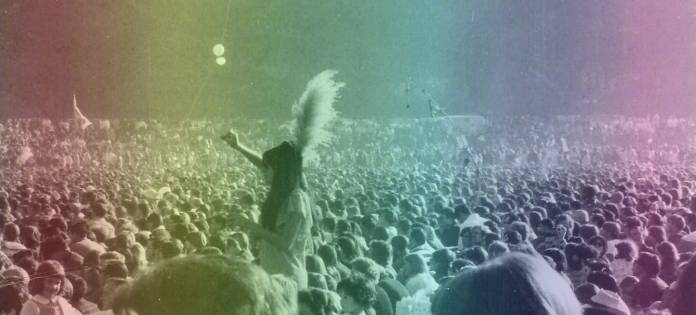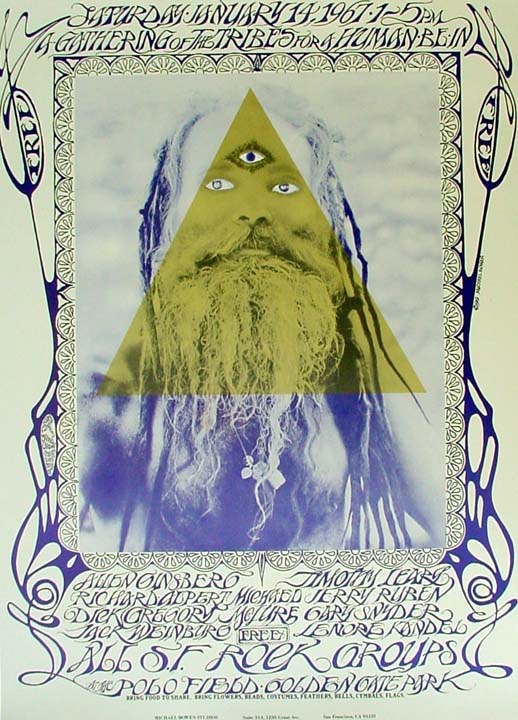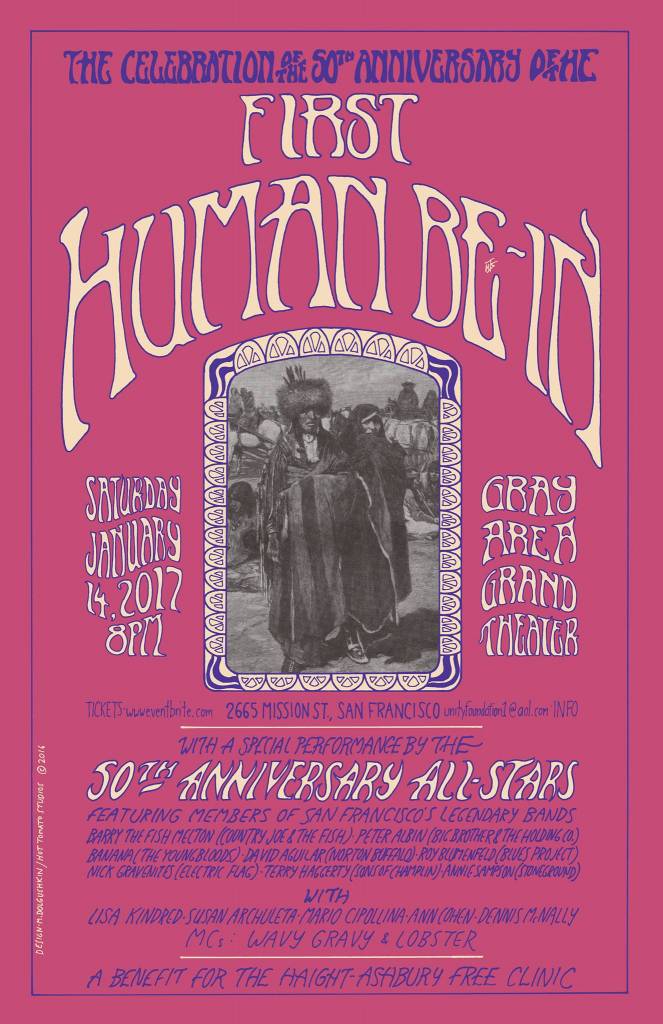
A huge celebration Sat/14 marks the 50th anniversary of the Human Be-In, the Owsley-fueled convergence in Golden Gate Park that gathered ten of thousands of earnest long-hairs for a day of Timothy Leary and spangled bodysuits — and which set the stage for the Summer of Love. “We shared our ideas about using magical and conscious energy to destroy the Pentagon as the symbol and seat of evil,” remembered organizer and SF Oracle publisher Allen Cohen of the pacifist gathering.
But the Pentagon is still here? And only getting more evil, one might add. In 2017, it’s easy to be nonplussed by the historic grooviness.
But as Michael Gosney, founder of San Francisco’s Digital Be-In explains, the hippies left us with more than just Janis Joplin and lentil loaf.
Gosney started the Digital Be-In long after the hippies left the Haight, in 1989 when he was the publisher of Verbum, a digital magazine on tech culture. At first, the event’s name was a tongue in cheek reference, “just the super cool party of MacWorld Expo that everybody wanted to get into,” as Gosney puts it.

But as time passed, he and other organizers (a group which later grew to include original Be-In producers Cohen, Leary, and Chet Helms) shifted the focus to their deeply held belief that digital technology could indeed be used towards our spiritual and physical liberation — that the humanistic values espoused at the Human Be-In were within our technological reach.
And so, the Digital Be-In became a yearly celebration of digital thought, interspersed with cautionary tales as the Electronic Freedom Foundation (EFF) became a key collaborator, adding news from its battle for digital consumers’ rights to the Be-In alongside sets from George Clinton and a young Bassnectar, and talks from Dennis Peron and Mayor Willie Brown.
No longer just a rave for hip programmers, the Digital Be-In is now a sounding board for the real issues that technology brings to our lives — with sick visual projections, obviously. (Some things don’t change.)
On Sat/14, the Digital Be-In will take over Grey Matter Grand Theater for an event to mark the 50th anniversary of the original Golden Gate Park event. Wavy Gravy will emcee a program of speakers and musicians, and tech demos include the Stanford Ocean Acidification Experience, a submarine virtual reality experiment. Tickets for the sold-out happening will go to support the Haight Ashbury Free Clinic.
We spoke with Gosney about how the Summer of Love led to the personal computer, and the perils that tech has encountered since he first started producing the Digital Be-In in the halcyon days of 1980s Silicon Valley.
48 HILLS Are the social change tactics developed in the 1960s still relevant today?
MICHAEL GOSNEY Well … yes … but there are obviously a whole new level of tools and systems that are available to us for social change, in large part because of the web — MoveOn.org is just one example. I do think that the outcome of the Human Be-In, among other things, outlined the importance of peaceful demonstration. That was one of the reasons for the Be-In in the first place, to create a united philosophy on the part of the counterculture at the time, which was torn between the Berkeley radicals wanting to fight fire with fire and the Haight Ashbury community wanting to engage in peaceful protest.
48 HILLS Were you at the original Be-In?
MICHAEL GOSNEY No I was not. I was a kid in the suburbs in Kansas City.

48 HILLS Were you aware of it at the time?
MICHAEL GOSNEY I don’t think I was even aware of it at the time, to be honest. It was in later years that I heard of it and it was in the mid ’80s in San Francisco that I started to see the makeup of the culture and how it was so amazingly cross disciplinary with the psychological, psychedelic dimension, the social justice dimension, the environmental consciousness, the activism, all these different factors in the Bay Area that came together to create a much more humanistic look at what our technology could give us, rather than what would have occurred if it were left in the East Coast, IBM mentality of top down, centralized computing and so forth. The whole concept of the personal computer really did come out of that milieu. Stewart Brand [founder of the Whole Earth Catalog] who is one of the leaders of the whole countercultural movement, he considered personal computers to be one of the main products of the entire counterculture.
48 HILLS Is psychedelic culture still a big part of the Digital Be-In?
MICHAEL GOSNEY Not really. I think that psychedelic culture, just like all these other threads, has evolved since the ‘60s. That’s a very interesting theme to follow, the opening up over the past couple years of new research into the use of psychedelics for therapy and so forth. Here in San Francisco, the CIIS [California Institute of Integral Studies] has a psychedelic assisted therapy certificate program, it’s the first in the world. I see that as evolving in its own way, the whole reassessment of psychedelics in our culture.
But I think it’s already pretty much an understood thing that a lot of the technological innovations came as a result of the influence from psychedelics directly, and the culture that was influenced by psychedelics. It would be a good idea, I think, for some of our technology visionaries these days to explore psychedelics if they haven’t. But LSD microdosing is a huge moment in Silicon Valley, are you aware of that? The motivations in microdosing is to get ahead. In a way, it’s a different context — we’re not going to seek the deeper meaning of how society functions, rather we’re going to fine tune our brains so that we can be better programmers, that’s what’s going on with the influence of microdosing. But I don’t consider it that important these days. What’s more important is just having a conscious with technology.
48 HILLS The Digital Be-In has long been associated with the EFF and its fight for online consumer rights, among other social organizations focused on digital justice. What do you see as the biggest technological threat in 2017?
MICHAEL GOSNEY The idea that we have a whole new kind of warfare going on. I mean that’s the threat, cyber warfare, as far as I’m concerned. I’m completely aligned with the EFF in trying to give some semblance of human rights to netizens, but the real problem is this terrible cyber espionage, all this warfare going on, terrible.
As usual, we’re the ones who started it — we’ve been manipulating, using the web in all these crazy ways. It’s kind of crazy to think about how many thousands of people and millions of millions of billions of dollars setting up this infrastructure to “protect us” — why don’t they protect us? They’re too busy spying on our own people. Why would this thing with Russia happen if we have all these sophisticated resources? I’m not an expert, I just watch what’s going on and I just think, good lord. I just feel the people, particularly the millennials who grew up with this technology, are starting to discover the downside of it all. I think we’re going to have some consumer movements dealing with the technology.
It is a dilemma to see these technology companies, who we know are generally progressive in their approach, being manipulated by the Justice Department in the ways that they have. We all as a culture need to speak up, we need to weigh in on this stuff, come to the defense of our technology companies in some sense, as well as critique them.
I’m interested in the world of transformative technology, consciousness hacking, which is dealing with biometric data and the censors, and neurofeedback technology, which all is very promising as far as contributing to the betterment of the human condition. But are we going to face the same problem of all the most intimate information about ourselves, the functioning of our bodies and mind also being accessed by the corporate network? I think it’s very unsettling.

48 HILLS How do you see the Digital Be-In comparing to MacWorld? These are both gatherings of people who are involved in technology, the industry.
MICHAEL GOSNEY Well at the time the Digital Be-In was just the super cool party of MacWorld Expo that everybody wanted to get into. It was all the creative people. And of course, the Macintosh was the creative computer. All the hip journalists, the programmers, the artists, they all wanted to come to the Verbum Be-In party. The fifth and sixth ones, I had Bill Graham Presents produce it with me, and they were 3,000 person, big events. They were pretty epic, tribal events. Larry Harvey was at the early events promoting Burning Man, the festival was still very small out there. Larry gave some great talks, actually.
We’re talking about the Digital Be-In here, but this whole legacy of the Human Be-In, a lot of people in looking back are like what happened to that, where did the counterculture go? I’m like, what do you mean where did it go? What do you think Burning Man is? Burning Man is the evolution of this. So is Symbiosis, so is How Weird Street Fair. It’s all that same lineage of community empowerment and celebration and activism and creativity, leveraging digital resources. Earthdance, I’m involved with that, that’s an international event for peace that emerged from the web, 100 events during the September Day of Peace. That’s what I often remind people of, that San Francisco is still playing its role as a cultural vanguard. Our modern events are part of this lineage.
48 HILLS Given the results of the election … I’m from San Francisco and something that I worry about is that the cultural events that take place there tend to be limited to San Francisco. I sometimes wonder about what their cultural impact is beyond the communities that they are explicitly a part of. Those events you mentioned, Burning Man, Symbiosis, How Weird Street Fair, are those enough in this Trump era?
MICHAEL GOSNEY Maybe not! Maybe there are some new kinds of events that are going to be emerging. The Million Woman March (laughs), I guess is a sign of what is to come. I have a feeling that in spite of the very real dangers that we face with this guy, it’s also shaking things up, bringing out more and more transparency with how things work.
I do believe that people have been shocked out of their complacency now. We became very complacent — we being the more progressive movement, though I object to that phrase, by the way, progressive, liberal, all this crap. We are just evolutionary. That’s the best term, as far as I’m concerned, for culture that wants to move forward and improve the human condition, it’s the evolution of the human species. The Trump thing is trying to dial back the cultural clock. I have a feeling that they’re going to have some victories from their point of view, but those things will be overturned. It’s not so much protesting as building alternatives. I’m in touch with many groups who are working hard to create new solutions and I think they’re going to be more visible and working even harder now.
48 HILLS Do you still see digital technology of a means of liberation?
MICHAEL GOSNEY I think that transformative technology, consciousness hacking, new virtual reality, mixed reality applications, I think these are going to definitely contribute to liberation both on a personal level, understanding oneself better, and on a social level, understanding the power of group intention. Our ability to mobilize people is really quite profound. The impetus to mobilize is going to be growing. Yes, I do think that digital technology is still a means of liberation. No doubt about it.
HUMAN BE-IN 50TH ANNIVERSARY CELEBRATION
Sat/14, 7pm-2am, sold out
Gray Area Grand Theater, SF
More info here.


Well, I actually was there in ’67, and I’m way skeptical about this conflation of the rebellious and revolutionary temper of those times with the mega-corporate predatory capitalism of the tech companies. I mean, who do these guys think they’re kidding?
Instead, I’ll be taking a walk out to the old polo field for a bit of reflection on the past half century. Anybody care to join me?
Alas, this event is all sold out. Sigh.